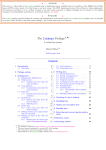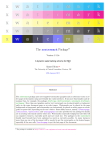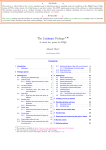Download keyreader-guide.
Transcript
I,H The keyreader Package A robust interface to xkeyval package c Ahmed Musa 2010-2012 Ahmed Musa1 17th January 2012 Summary The keyreader package provides robustness and some extensions to the xkeyval pack- age. It preserves braces in key values throughout parsing and saves estate when defining keys. Also, the command \krdsetkeys allows unbalanced conditionals to be parsed as values of keys. Furthermore, when the command \krddefinekeys is used, keys are initialized as soon as they are defined, and, unlike in the xkeyval package, admissible alternate values of choice keys can have individual callbacks. The looping macros of the xkeyval package are redefined, to increase robustness. The command \define@key of the xkeyval package has had two of its subordinate commands redefined, to offset a complaint about the grabbing of the key’s callback when defining keys with \define@key. This user manual assumes that the reader is familiar with some of the functions and user interfaces of the xkeyval package. This work (i. e., all the files in the keyreader package bundle) may be distributed and/or modified under the conditions of the LATEX Project Public License (LPPL), either version 1.3 of this license or any later version. The LPPL maintenance status of this software is ‘author-maintained.’ This software is provided ‘as it is,’ without warranty of any kind, either expressed or implied, including, but not limited to, the implied warranties of merchantability and fitness for a particular purpose. c MMXII Contents 1 Motivation 1 2 User commands 2.1 Defining keys . . . . . . . . . . . . . . . . 2.2 Setting keys . . . . . . . . . . . . . . . . . 2.3 Examples . . . . . . . . . . . . . . . . . . 2 3 4 1 2.4 Disabling keys . . . . . . . . . . . . . . . . 2.5 Options processing . . . . . . . . . . . . . 6 6 2 3 Version history 6 Index 8 Motivation The keyreader package predated the ltxkeys package and was developed to make key parsing by the xkeyval package robust (in the sense of preserving outer braces in key values throughout I H 1 The package is available at http://mirror.ctan.org/macros/latex/contrib/keyreader/. This user manual corresponds to version 0.4b of the package. The University of Central Lancashire, Preston, UK. [email protected]. The keyreader package 17th January 2012 parsing and enabling the parsing of key values with unbalanced conditionals), as well as reduce the amount of typing that is required for defining several keys. To achieve robustness in key parsing, the \setkeys command of the xkeyval package has been patched and renamed \krdsetkeys. The xkeyval package’s \setkeys remains unchanged, to avoid breaking existing codes that rely on it’s current form. Some other low-level commands of xkeyval package have been patched and renamed. The keyreader package provides commands for compactly defining and setting all types of key (ordinary, command, boolean, and choice). Also, the keyreader package introduces the concept of callbacks for the alternate/admissible values of choice keys defined via the command \krddefinekeys. Moreover, when \krddefinekeys is used, keys are automatically set/initialized as soon as they are defined. This provides default definitions for the key macros and functions. Boolean keys are initialized with a value of false irrespective of their default values. The keyreader package has been used as a development platform for the ltxkeys package because the xkeyval package, on which the keyreader package is based, has been quite stable for some years, its inherent shortcomings not withstanding. Has the user ever tried to pass to xkeyval package’s \setkeys an unbalanced conditional as the value of a key? He/she will quickly be hit by the error message ‘! Incomplete \ifx; all text was ignored after line . . . ,’ or something similar. This limitation has been removed by the keyreader package. 2 User commands 2.1 Defining keys The syntax for defining keys is: New macro: \krddefinekeys 1 \krddefinekeys?[hkprefixi]{hkfamilyi}[hmprefixi]{hkeylisti} The optional hkprefixi and mandatory hkfamilyi have unambiguous connotations. The optional hmprefixi is the macro prefix, in the parlance of the xkeyval package. The default values of hkprefixi and hmprefixi are KRD and krdmp@, respectively. In the case of ordinary, command and boolean keys, hkeylisti has the syntax Syntax of key keylist 2 { hkeytype-1i/hkeyname-1i/hdefault-1i/hcallback-1i; hkeytype-2i/hkeyname-2i/hdefault-2i/hcallback-2i; ... hkeytype-ni/hkeyname-ni/hdefault-ni/hcallback-ni; 3 4 5 6 7 } The list parser for hkeylisti is invariably semicolon ‘;’. Hence, if the user has semicolon ‘;’ in hcallbacki, it has to be wrapped in curly braces, to hide it from TEX’s scanner. hkeytypei can be any member of the list {ord (ordinary key), cmd (command key), bool (boolean key), choice (choice key)}. For choice keys, hkeylisti has the syntax Syntax of key keylist 8 9 { hkeytype-1i/hkeyname-1i/hdefault-1i/halti/hcallback-1i; Page 2 of 8 The keyreader package hkeytype-2i/hkeyname-2i/hdefault-2i/halti/hcallback-2i; ... hkeytype-ni/hkeyname-ni/hdefault-ni/halti/hcallback-ni; 10 11 12 13 17th January 2012 } The alternate values (also called nominations or admissible list of user input) halti has the syntax Syntax of alternate list for choice keys 14 15 16 17 hvalue-1i.do=hcallback-1i, hvalue-2i.do=hcallback-2i, ... hvalue-ni.do=hcallback-ni, The list parser in this case is invariably comma ‘,’. The star (?) sign on \krddefinekeys is an optional suffix. If it is present, then only definable (i. e., non-existent) keys will be defined. The existence of a key depends on hkprefixi and hkfamilyi, since keys are name-spaced. Note 2.1 Choice keys defined by \krddefinekeys are of the starred (?) variant of choice keys (see the xkeyval package guide). Hence they will always convert the user input into lowercase before matching it against the alternate/admissible list of values specified at key definition time. The matching, as done by \krdsetkeys, is catcode-agnostic. 2.2 Setting keys The command \krdsetkeys is a more robust counterpart of the xkeyval package’s \setkeys, in the sense that it preserves all outer braces in the values of keys and allows the parsing of key values with unbalanced conditionals. The new command \krdsetkeys has the same syntax as the original \setkeys of the xkeyval package, namely New macro: \krdsetkeys 18 \krdsetkeys?+[hkprefixi]{hfamiliesi}[hnai]{hhkeyi=hvalueii} As usual, the star (?) and plus sign (+) are optional suffixes. The starred (?) variant will save all undeclared keys in the list \XKV@rm, possibly for setting later with the command \setrmkeys, and will not report any unknown key as undeclared. The plus (+) variant will set the given keys in all the given families, instead of in just one family. The combination ?+ will set the listed keys in all the given families and append unknown keys to the container \XKV@rm. hnai is the list of keys that shouldn’t be set in the current run. The command \krdsetkeys isn’t exactly xkeyval package’s \setkeys, since the former is more robust and avoids the selective sanitization of hkeyi=hvaluei list that is done by \setkeys. The macro \krdsetkeys ‘normalizes’ the hkeyi=hvaluei or comma-separated key list. Therefore, users of the keyreader package should always call the command \krdsetkeys instead of \setkeys. Both have the same user interface. The \setkeys command of the xkeyval package’s remains unchanged. The xkeyval package’s command \setrmkeys, which sets ‘remaining keys,’ has also been modified to \krdsetrmkeys, while keeping \setrmkeys unchanged. Users of the keyreader package should use \krdsetrmkeys in place of \setrmkeys. Page 3 of 8 The keyreader package 17th January 2012 2.3 Examples Examples 2.1: \krddefinekeys, \krdsetkeys 19 20 21 22 23 24 25 26 27 28 29 30 31 32 33 34 35 36 \krddefinekeys*[KV]{fam}[pnt@]{% % ‘#1’ throughout here refers to the user input for the key. ord/keya/{black}/\def\xx##1{#1##1}; cmd/keyb/\@fisrtofone/\def\y##1{#1##1}; bool/keyc/true/\def\z##1{#1##1}; choice/keyd/center/ center.do=\def\vcp@align{center}\def\w##1{#1##1}, left.do=\def\vcp@align{flushleft}, right.do=\def\vcp@align{flushright}, justified.do=\def\vcp@align{relax}/ \ifkrddef\else \def\xa##1{#1##1} \fi; ord/keye/{keye-default}/\def\y##1{#1##1} } \krdsetkeys[KV]{fam}[keyb]{keya={green},keyb=\@iden,keyc=false,keyd=left} % Setting keys with values having unbalanced conditionals: \krdsetkeys[KV]{fam}{keye={\iffalse keye-value}} The braces around ‘green,’ the value of keya, will be preserved throughout parsing. It should be remembered that keys are automatically set as soon as they are defined by \krddefinekeys. The boolean \ifkrddef is true when \krddefinekeys is defining keys, and false otherwise. The essence of it is that since keys are set as soon as they are defined by \krddefinekeys, some actions should not be executed at this time, until the keys are being set by the user. Using the keys defined in the above example, let us make comma ‘,’ and comma ‘=’ active and see how the keyreader package will deal with them. Example 2.2: Active comma and equals sign 37 38 39 40 41 42 43 44 45 46 47 48 % Make comma ‘,’ and equal ‘=’ active to test the list normalization % scheme of ‘keyreader’ pacakge: \begingroup \catcode‘\,=13 \catcode‘\==13 \gdef\keylista{{fam,famb}[keyb , keyc]{keya = {green} , keyb = \@iden , keyc = false , keyd = left, keye = somevalue}} \gdef\keylistb{\krdsetrmkeys?+[KV]{fam,famb}} \endgroup \def\reserved@a{\krdsetkeys?+[KV]} \expandafter\reserved@a\keylista \keylistb The output of the following example is shown in Figure 1: Example 2.3 49 50 51 52 \documentclass{article} \usepackage{keyreader} \usepackage{xcolor} \makeatletter Page 4 of 8 The keyreader package 53 54 55 56 57 58 59 60 61 62 63 64 65 66 67 68 69 70 71 72 73 74 75 76 77 78 79 80 81 82 83 84 85 86 87 88 89 90 91 92 93 94 95 96 97 98 99 100 101 102 103 104 105 17th January 2012 \newdimen\shadowsize \krddefinekeys*[KV]{ebox}[mp@]{% bool/frame/true; bool/shadow/true; cmd/framecolor/black; cmd/shadecolor/white; cmd/shadowcolor/gray; cmd/framesize/.4pt; cmd/boxsize/.1\columnwidth; cmd/shadowsize/1pt; choice/align/center/ center.do=\let\mp@alignright\hfil\let\mp@alignleft\hfil, right.do=\let\mp@alignright\hfill\let\mp@alignleft\relax, left.do=\let\mp@alignright\relax\let\mp@alignleft\hfill, justified.do=\let\mp@alignright\relax\let\mp@alignleft\relax / \def\userinput{#1}; } \savekeys[KV]{ebox}{frame,framecolor,framesize} % ‘Preset keys’ have no ‘tail keys’: \krdpresetkeys[KV]{ebox}{% frame,framecolor=black,framesize=0.5pt,boxsize,align } % ‘Postset keys’ have no ‘head keys’: \krdpostsetkeys[KV]{ebox}{% shadow=\usevalue{frame},shadowcolor=\usevalue{framecolor}!40, shadowsize=\usevalue{framesize}*4 } \newcommand*\ebox[2][]{% \setkeys[KV]{ebox}{#1}% % What happens if we use the following, instead of the above \setkeys? % Preset and postset keys wouldn’t be set when ‘#1’ is empty: % \krdifblank{#1}{}{\setkeys[KV]{ebox}{#1}} \begingroup \ifmp@frame \fboxrule=\dimexpr\mp@framesize\relax \else \fboxrule=0pt \fi \ifmp@shadow \shadowsize=\dimexpr\mp@shadowsize\relax \else \shadowsize=0pt \fi \setbox0=\hbox{% \fcolorbox{\mp@framecolor}{\mp@shadecolor}{% \hbox to\mp@boxsize{% \mp@alignright #2\mp@alignleft }% }% }% \hskip\shadowsize \color{\mp@shadowcolor}% Page 5 of 8 The keyreader package 106 107 108 109 110 111 112 113 114 115 116 117 17th January 2012 \rule[-\dp0]{\wd0}{\the\dimexpr\ht0+\dp0\relax}% \llap{\raisebox{\shadowsize}{\box0\hskip\shadowsize}}% \endgroup } \makeatother \begin{document} \ebox{ebox1} \ebox[framecolor=gray,boxsize=2cm,align=right]{ebox2} \ebox[shadow=false,boxsize=1.5cm,align=left]{ebox3} \ebox[framesize=1pt,framecolor=green,shadowcolor=blue]{ebox4} \ebox[frame=false,shadow,shadowcolor=yellow,framesize=.5pt]{ebox5} \end{document} Figure 1: Output of example 2.3 ebox1 ebox2 ebox3 ebox4 ebox5 2.4 Disabling keys The command \krddisablekeys has the same use syntax as the \disable@keys command of the xkeyval package, but will issue an error (instead of a warning) when an attempt is made to set a disabled key. 2.5 Options processing The commands \krdDeclareOption, \krdExecuteOptions and \krdProcessOptions are aliases for \DeclareOptionX, \ExecuteOptionsX and \ProcessOptionsX of the xkeyval package. 3 Version history The following change history highlights significant changes that affect user utilities and interfaces; changes of technical nature are not documented in this section. Version 0.4b [2012/01/14] The command \krdsetkeys can now parse key values with unbalanced conditionals. Version 0.4a [2011/12/23] The key list in \krddefinekeys shouldn’t have been normalized with respect to forward slash (/). Version 0.4 [2011/12/20] Several of the former functions of the package have been transferred to the ltxkeys package with even more robustness. The package now provides mainly a compact and robust interface to the features of the xkeyval package. Version 0.3 [2011/03/26] Bug fix. Page 6 of 8 The keyreader package 17th January 2012 Version 0.2 [2011/02/25] The interface for defining new keys now accepts conditionals in key macros/functions. A mechanism is provided for automatic setting up and execution of key functions with default key values. Version 0.1 [2010/01/10] First public release. Page 7 of 8 The keyreader package 17th January 2012 Index Index numbers refer to page numbers. A active comma and equals sign . . . . . . . . . . . . . . . . . 4 \krdsetkeys . . . . . . . . . . . . . . . . . . . . . . . . . . . . . . . . . . . . . 3 \krdsetrmkeys . . . . . . . . . . . . . . . . . . . . . . . . . . . . . . . . . . 3 D \DeclareOptionX . . . . . . . . . . . . . . . . . . . . . . . . . . . . . . . . 6 \disable@keys . . . . . . . . . . . . . . . . . . . . . . . . . . . . . . . . . . 6 disabling keys . . . . . . . . . . . . . . . . . . . . . . . . . . . . . . . . . 6 O options processing . . . . . . . . . . . . . . . . . . . . . . . . . . . . . 6 E examples . . . . . . . . . . . . . . . . . . . . . . . . . . . . . . . . . . . . . . . . 3 \ExecuteOptionsX . . . . . . . . . . . . . . . . . . . . . . . . . . . . . . . 6 K \krdDeclareOption . . . . . . . . . . . . . . . . . . . . . . . . . . . . . . 6 \krddefinekeys . . . . . . . . . . . . . . . . . . . . . . . . . . . . . . . . . 2 \krddisablekeys . . . . . . . . . . . . . . . . . . . . . . . . . . . . . . . . 6 \krdExecuteOptions . . . . . . . . . . . . . . . . . . . . . . . . . . . . . 6 \krdpostsetkeys . . . . . . . . . . . . . . . . . . . . . . . . . . . . . . . . 6 \krdpresetkeys . . . . . . . . . . . . . . . . . . . . . . . . . . . . . . . . . 6 \krdProcessOptions . . . . . . . . . . . . . . . . . . . . . . . . . . . . . 6 P Packages . . . . . . . . . . . . . . . . . . . . . . . . . . . . . . . . . . . . . . . . . . keyreader . . . . . . . . . . . . . . . . . . . . . . . . . . . . . . . . 1–4 ltxkeys . . . . . . . . . . . . . . . . . . . . . . . . . . . . . . . 1, 2, 6 xkeyval . . . . . . . . . . . . . . . . . . . . . . . . . . . . . . . . 1–3, 6 \ProcessOptionsX . . . . . . . . . . . . . . . . . . . . . . . . . . . . . . . 6 S \setkeys . . . . . . . . . . . . . . . . . . . . . . . . . . . . . . . . . . . . . . . . 3 \setrmkeys . . . . . . . . . . . . . . . . . . . . . . . . . . . . . . . . . . . . . . 3 U user commands . . . . . . . . . . . . . . . . . . . . . . . . . . . . . . . . . . 2 Page 8 of 8














